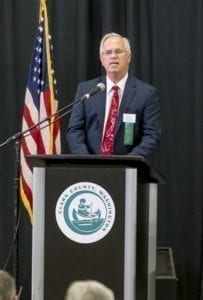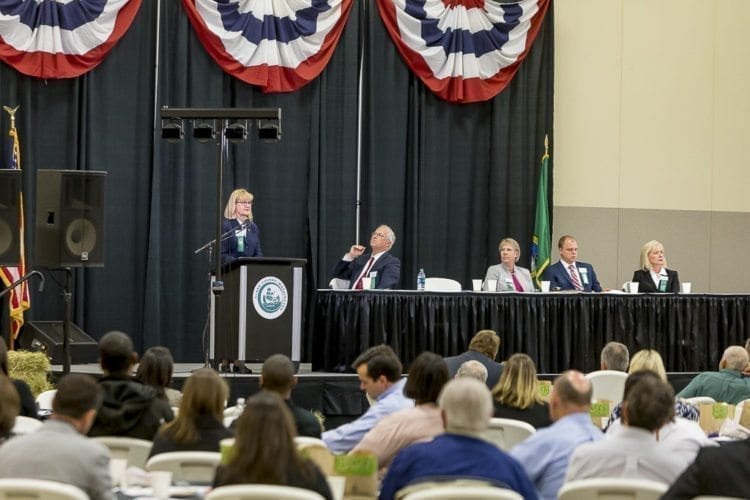County leaders lay out the possibilities and pitfalls facing Clark County
RIDGEFIELD — This summer, the Clark County Fair will celebrate its 150th anniversary. To honor that milestone, this year’s State of the County address was held at the Clark County Fairgrounds.

County Chair Marc Boldt noted that his daughter met her husband while helping out at the fair, so it was a place of special memories for him.

As for the state of the county, it is one of optimism and challenges as the region continues to grow at a rapid pace.
“Very much like Cougars football,” quipped Boldt. “It’s not so much that we lose as that we always seem to run out of time. That simply happens year after year.”
“We just completed our third review of the ’94 (Comprehensive) plan,” he continued. “Except for a little bit in Ridgefield and La Center, there’s very little land added for housing. And if they lose in court for the rural industrial land, at present there will be very little land for new jobs. So if that doesn’t change, prices will continue to go up and we will continue to search for land for jobs. With that, the next review will likely come sooner than seven years.”
“In the very big picture, we need to continue to recognize that Clark County is in a key location, in a key part of the country,” added Councilor Jeanne Stewart, whose district includes much of the city of Vancouver. “And, the opportunity for economic expansion today, and into the future, for strong growth we (must) remain competitive, flexible and innovative in Clark County.”
Part of that flexibility could come in the form of rail-dependent business along a 1.5-mile stretch of the county-owned Chelatchie Prairie shortline railroad. It’s a project Councilor Eileen Quiring, who’s also running for county chair, is particularly excited about.
“We’re running out of land for economic development in the county, and this is turning away businesses that otherwise would consider relocating or growing here,’’ Quiring said.
Quiring adds that they’re keenly aware of community concerns over the new development. “We will work to ensure that these development regulations protect public safety and livable neighborhoods, without stifling the much-needed economic development.”

Tolling concerns
A major shadow hanging over the region’s economic development, according to several council members, is the possibility of tolls in the Portland Metro area, and the impact on the people who live in Southwest Washington but work south of the Columbia River.

“Anyone who has crossed I-5 or I-205 bridges knows that congestion is a problem here, but tolls are not a definitive answer,’’ Quiring said. “I’m particularly concerned with Oregon’s proposal to impose value pricing — tolls — on many of the metro area’s freeways.’’
Quiring sits on the Value Pricing Advisory Committee. “I’m actually one of three,” she says, “(Vancouver Mayor Anne) McEnerny-Ogle serves on that committee, as well as a delegate from the Washington State Department of Transportation. There are 25 members, however, so only three voices from this side of the river.
’’My concern, both as a resident of Clark County and as a member of this committee, is that Southwest Washington residents should not need to bare the burden of improving transportation in a state where we don’t live, but where many of our residents work and pay taxes,’’ Quiring said.
“My goal for the Value Pricing Committee is to be a voice of reason and to protect the interests of Clark County residents,’’ Quiring said. “I hope Oregon will join Washington for the bi-state discussion about improvements for the I-5 corridor and how we can make improvements for a financing plan that is fair and equitable for Clark County residents.’’
Stewart echoed Quiring’s concerns, and added that the county needs to be a strong voice in that discussion. She also favors a more radical option for easing congestion on the two Interstate freeways.
“Exploration of a third crossing corridor for the Columbia River,” she says, “(would) ensure Clark County has adequate transportation infrastructure on I-5 and I-205 to continue our healthy growth and expansion.”
Housing codes changing
While the county is struggling with finding new areas for growth, the council has been seeking new ways to increase housing to offset growing costs. One is new rules that govern Accessory Dwelling Units.
“Under the new, more flexible regulations,” said Councilor John Blom, “ADU’s will be allowed for the first time in rural areas.”
Those ADU’s must be attached units, such as basements or garages, up to 1,600 square feet. The county is also amending its development codes to allow more cottage housing.
“Cottage housing is a way to use land more efficiently,” Blom explains, “It’s a group of small, single-family detached houses around a common area, with a coherent plan to develop the site. These homes can be as small as 150 square feet, or as large as 1,600 square feet.”
Homelessness and crime
Many of those changes are seen as a way to help offset a growing homeless problem in the county, which is extending outside of the city of Vancouver. Blom says the county assisted more than 6,500 homeless individuals in the 12 months ending last November.
“I believe that how we deal with homelessness is a measure of who we are as a community,” says Blom.
The county is also set to receive $600,000 from the state to help build a mental health triage center along Lower River Road near the work release center.
“This will be a place where people can go and get the help that they need,” says Blom, “and that our community owes them and should provide to them.”
In terms of crime in the county, Boldt pointed out that taxpayers footed the bill for more than $6 million last year for public defenders, with the state chipping in only $25,000. He expects that to be a major point from the county for the next legislative session, calling it a constitutional issue.
One of the biggest issues facing the county is the need for a new jail. On Tuesday, the council approved a Blue Ribbon Commission to explore options for a new facility.
“Our current jail facility is over-crowded, it’s outdated, and it no longer serves the needs of our community,” says Councilor Julie Olson. “It was designed in the 1970’s, and built in the 1980’s at a time when the county population was much lower, and at a time when most jail practices were from the 1950’s and ’60s.”
Of course new jails, more parks and sidewalks, and increased need for homeless services don’t come cheap. In an effort to assist with the budgeting process, the county is moving from General Fund budgeting, to Program Budgeting.
“We started this process last year,” says Olson. “Departments are now identifying programs, and adding descriptions and attributes to those programs. And this year they’ll actually be adding costs to those programs.”
The goal, she says, is better transparency with taxpayer money.
“Program-based budgeting is going to create visibility into what we do, for whom, and for how much,” adds Olson, “And with program-based budgeting we, with your input, will be able to make meaningful budget decisions, we’ll be more accountable to you, the voters and the taxpayers, and I can’t wait to get this fully implemented.”
A final bit of business the council hopes to have wrapped up soon is the selection of a new county manager. Two finalists for the job selected earlier this year were deemed not to be a good fit, and the selection process began again. Boldt says they have interviews with candidates coming up soon.
“Government, like private sector, can no longer be satisfied with the status quo,” says Boldt. “Last year we took the bold step of changing leadership. Many questioned that, but we took it, and we felt it was necessary. It was focused on the promising future, and we know it won’t come on its own … We want the very best for you, and we want the very best for the county.”
Clark County was hit particularly hard during the recession a decade ago. But the past few years have seen that recovery completed, and the region become the focus of some of the most rapid growth in the state. For now, the state of Clark County can be summed up in just two words — cautious optimism.




